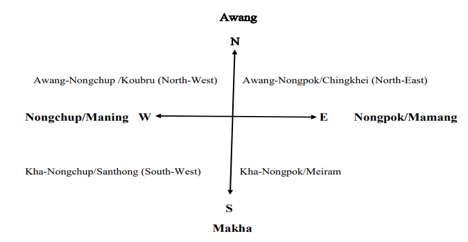In Manipur, quite often people use the words for the directions East, West, North and South in English rather than the Meeteilon/ Meiteilon versions Nongpok (East), Nongchup (West), Awaang (North) and Kha (South), respectively. This may be due to the influence of the English language through various platforms such as the media, schools, magazines, and the various other activities such as organized talks, seminars or conversations which include non-Meeteilon/Meiteilon speakers. In addition to these four directions, there is also Chingkhei (North-East), Koubru (North-West), Meiram (South-East), and Santhong/Moiranglaiji (South-West), respectively, as shown here:

These Meeteilon/Meiteilon terminology for directions are often used in religious rituals, astrology and other religious matters. However, the terminology of Meeteilon/Meiteilon directions are commonly used more than Chingkhei, Koubru (North-West), Meiram (South-East), and Santhong/ Moiranglaiji, which are rarely used even by the older generations. It is believed that the directions Chingkhei is guarded by the god, Marjing; Koubru is guarded by the god, Koubru; Meiram is guarded by the god, Wangbren; and Santhong/ Moiranglaiji is guarded by the god, Thangjing. Meeteilon/ Meiteilon also has deictic markers such as –sin– (inward), –thok– (outward), –khət-(upward), and –thə-(downward) which are shown next:

An example with the deictic marker –sin– is as follows (deic refers to dietetic marker, and nmz refers to Nominalizer, terms that we need not worry to get the meaning in each case):
(1) mu-sin-ba
black-deic-nmz
‘to become black’
An example with the deictic marker –thok– is as follows:
(2) ŋəu-thok-pa
fair/white-deic-nmz
‘to become fair/white’
An example with the deictic marker –khət– is given below:
(3) wəŋ-khət-pa
tall-deic-nmz
‘to become tall’
An example with the deictic marker –thə– is given below:
(4) nem-thə-ba
small/short-deic-nmz
‘to become small/reduce height(shorter)’
Other deictic markers in Meeteilon/ Meiteilon are -rə/-lə, -ru/lu-, -rək/-lək , -khi-, -khə-, -khai- . Some examples with these deictic markers are given below:
(5) mahak cak ca-rə-re
3P rice eat-Deic-Perf
‘He/she (came here and) ate rice.’
(6) mahak cak ca-ru-re
3P rice eat-Deic-Perf
‘He/she (went there and) ate.’
(7) mahak cak ca-rak-le
3P rice eat-Deic-Perf
‘He/she ate rice(from there).’
(8) mahak cak ca-khi
3P rice eat-Deic.Simple Asp
‘He/she ate rice.’
(9) bom po-khai-re
bomb explode-Deic-Perf
‘Bomb exploded.’
The deictic markers such as –sin– (inward), –thok– (outward), –khət-(upward), –thə-(downward), -rə/-lə, -ru/lu-, -rək/-lək , -khi-, -khə-, -khai etc are used more often as compared to the directions Nongpok (East), Nongchup (West), Awaang (North), Kha (South), Chingkhei (North-East), Koubru (North-West), Meiram (South-East), and Santhong/Moiranglaiji (South-West). The abundance of the deictic markers in Meeteilon/Meitelon may be another reasons why most of the people in Manipur do need to actually name the directions while addressing or while directing a way.